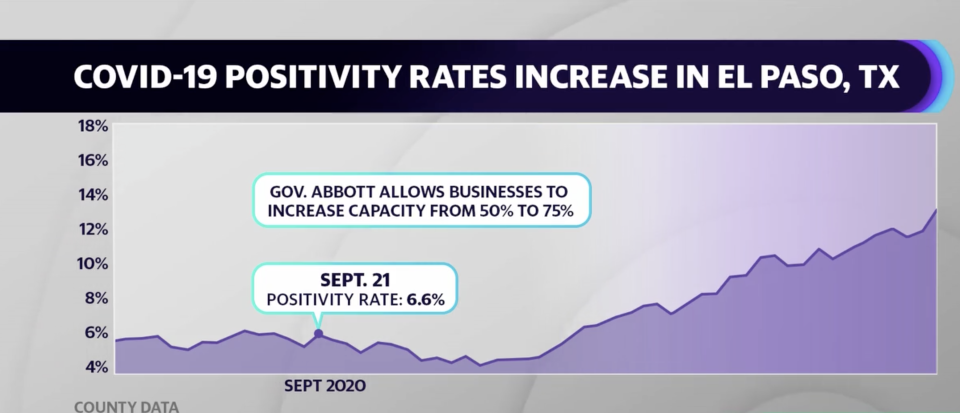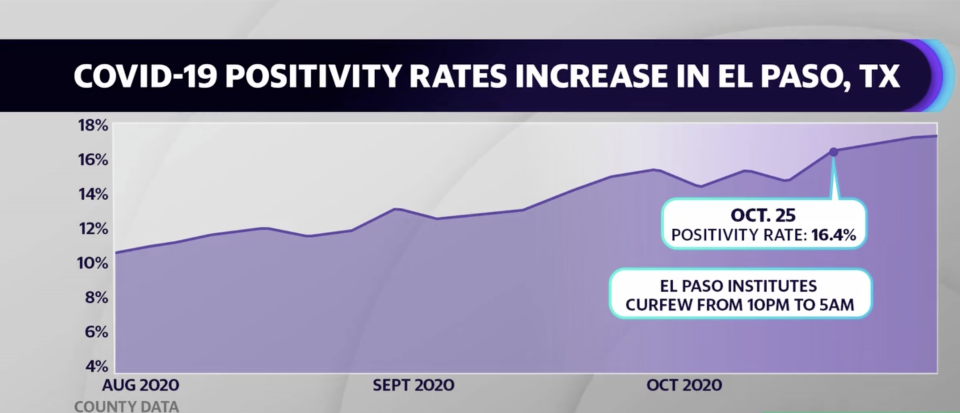El Paso returning to coronavirus lockdown could be a sign of more to come in the US
After the Mayor of El Paso, Texas voted to block even limiting capacity constraints beyond a 50% reduction at bars and strip clubs, the county announced late Thursday after a Yahoo Finance interview that it would institute a two-week lockdown for non-essential businesses as COVID-19 cases spiral out of control.
Earlier this week, El Paso saw its new cases spike to hit the highest average for any county in the U.S., adjusted for population size, according to Johns Hopkins data as hospitals prepared to treat patients in overflow areas. But critics say the failure to control the rise in cases has been predictable given the guidelines in place that proved to be too lax.
In an interview with Yahoo Finance before the policy changes were announced, Mayor Dee Margo placed the blame on “COVID fatigue.”
“We think people let their guards down, they stopped wearing masks,” Margo said.
However, a review of the state’s reopening plans and a weak response at the county level to rising cases would seem to indicate the 300% increase in hospitalizations over the past three weeks point to a larger issue of jurisdiction and a fractioned response at the federal, state, and local levels.
In its reopening orders at the state level, Texas Governor Greg Abbott allowed businesses to increase capacity from 50% to 75% occupancy beginning September 21, unless a region’s hospital patients constituted more than 15% of total hospitalizations. That metric was different from New York Governor Andrew Cuomo’s emphasis on tying regions reopening in that state to a threshold of coronavirus test positivity rates, a more leading indicator of spread than hospitalizations. In New York City, despite a test positivity rate of 2%, indoor dining remains capped at 25% occupancy.

After businesses increased capacity for weeks under the Texas governor’s orders, El Paso’s positivity rate jumped to 13% on October 15 and COVID-19 patients constituted 28% of the area’s hospital load. That triggered an automatic reduction in occupancy at restaurants and bars back down to 50%, but new daily cases continued to spike out of control. This Sunday, El Paso County Judge Ricardo Samaniego instituted a curfew from 10 p.m. to 5 a.m. as a last ditch control effort.

But as Margo revealed to Yahoo Finance, attempts to work with Abbott to reduce capacity constraints below 50% before that curfew went in place were blocked by the governor’s office.
“The Judge and I went to the governor on Saturday night to work on this,” Margo said. “We asked for a reduction to 25% [capacity], and the governor’s office said, ‘No, we want to help you enforce what you’ve done already to see what it does in the wake of these spikes.’”
Unsatisfied with the curfew order in place going far enough as the case positivity rate swelled past 17%, El Paso’s City Council held a vote to shut down strip clubs on Tuesday. With the vote split, Margo blocked the attempt, citing guidance from the city attorney who said it was not within El Paso’s jurisdiction to circumvent the state’s order to allow businesses to operate at 50% capacity.
“The question was what can we do legally given the state [orders in place,]” the mayor said. “My point wasn’t keeping strip clubs open or anything else. It was we can only use certain legal tools.”
Following Yahoo Finance’s interview with the mayor and the worsening state of the county’s spread, Samaniego announced a two-week lockdown for all non-essential businesses, including in-person dining establishments, gyms, and salons. That order drew immediate criticism from Texas State Attorney General Ken Paxton, with his office’s Twitter account stating, “My office is quickly exploring all legal actions.”
El Paso County Judge Samaniego has no authority to shut down businesses in El Paso County. This is a direct violation of @GovAbbott’s executive order.
My office is quickly exploring all legal actions.— Texas Attorney General (@TXAG) October 30, 2020
El Paso is far from unique in the legal challenges or questions of jurisdiction in measures being taken to battle community spread. In Florida, Governor Ron DeSantis’ more aggressive reopening plans superseded more cautious mayors. In Pennsylvania, a Trump-appointed federal judge ruled Governor Tom Wolf’s lockdown orders were unconstitutional after they were already lifted due to improving case counts. But those challenges do raise concerns about what tools might remain available in those states to limit outbreaks should cases begin to rise again.
As Dr. Tom Tsai, assistant professor in Department of Health Policy and Management at the Harvard Global Health Institute, recently highlighted, there is cause for concern that a spike in COVID-19 deaths might also follow as hospitalizations tick higher in the wake of the nation’s record daily cases.
“We are not rounding the corner. Cases are actually increasing. Hospitalizations are increasing. Admissions to intensive care units are increasing, and unfortunately, deaths are starting to increase as well,” he said citing county level data. “As we know, death is a lagging indicator and the next couple of weeks may bear an even more grim picture on the true consequences of the out-of-control infection from the last several months.”
Zack Guzman is the host of YFi PM as well as a senior writer and on-air reporter covering entrepreneurship, cannabis, startups, and breaking news at Yahoo Finance. Follow him on Twitter @zGuz.
Read the latest financial and business news from Yahoo Finance
Follow Yahoo Finance on Twitter, Facebook, Instagram, Flipboard, SmartNews, LinkedIn, YouTube, and reddit.
Find live stock market quotes and the latest business and finance news
For tutorials and information on investing and trading stocks, check out Cashay